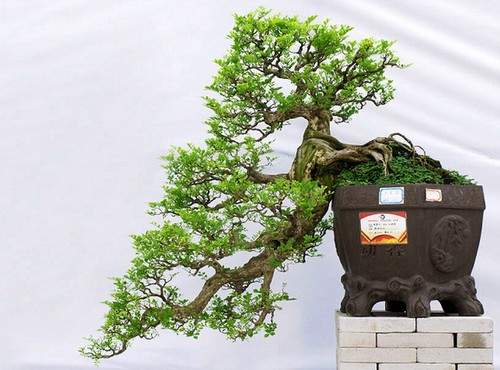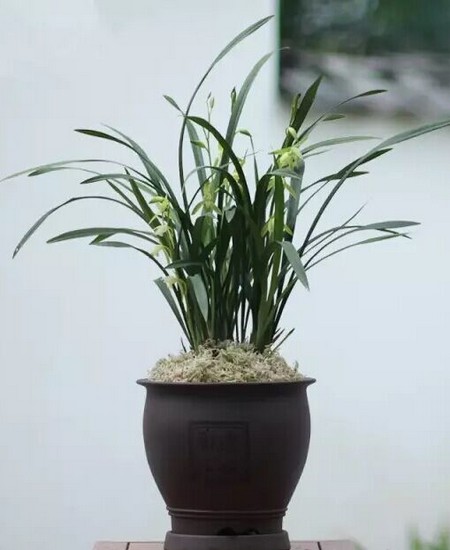A Technique for Accelerating the Early Formation of Lingnan Bonsai--Bending and Joining
"cutting dry and storing branches" is the main artistic technique of creating Lingnan bonsai, which is mainly pruned and sawed to form a big tree-shaped bonsai that is vigorous and natural, tall and straight and unrestrained, which is the modeling result of Lingnan bonsai artists from nature and learning from nature for a long time.
However, the pruning skill of "cutting dry branches" requires patience and perseverance, and it is also time-consuming. As stated in the work of the late bonsai master Kong Taichu: "every inch of a branch is trimmed, it takes a year or two to trim a fine bonsai with luxuriant branches and vibrant leaves, and it takes more than ten or twenty years or more." As the saying goes, "an inch of branches have been born for several years, and Jiajing has become ten years old." How many ten or twenty years can there be in a person's life?

In this era of deepening reform and opening up, people from all walks of life and work have to adapt to the "fast pace". Efficiency is life, and time is money. Bonsai artists how to keep up with the pace of the times, shorten the forming time of Lingnan bonsai and accelerate the achievements of Lingnan bonsai is one of the main topics of several Lingnan bonsai seminars. This paper makes a brief analysis of the experience of using the "bending method" to accelerate the early formation of Lingnan bonsai for reference.
1. "flexion method" this is the experience and method that I have applied to the modeling of Lingnan bonsai branches for many years-that is, to skillfully make use of their own growing long branches and do not cut them off in proportion to the trunk (not wasted). Bending connection molding method.
1. Specific operation methods:
(2) required operating tools and materials: sterilized handsaw, sharp knife, transparent adhesive tape, small bamboo, plastic hose, aluminum wire, manual rubber suction ball, etc.
(3) determine the flexion position of the branch: determine the length of the node and node of the branch that needs flexion, saw a saw blade by hand, and then cut the outside of the saw flat with a sharp knife. The bending angle is inversely proportional to the bevel, and the smaller the angle is, the larger the oblique incision is (pay attention to put an end to the dead bend).
The direction of flexion branch, or up and down, or left and right, or floating branch, falling branch, hanging branch, balanced branch, etc., should be determined according to the design of stump branch shape.
(4) binding and fixing: blow the sawdust in the saw incision with a manual rubber suction ball, and press the branch down slowly to see whether the branch angle is satisfactory and whether the saw incision is consistent, otherwise it should be modified. Then, use aluminum wire to put a small steel nail on the front end of the curved branch and the tree trunk, and add a small piece of bamboo to this part to prevent the wire from falling and kidnap and tie it firmly. Make sure the saw cut is tight and consistent.
(5) press the flexion joint, seal the wound and eliminate the artificial trace: first seal the flexion interface with transparent adhesive tape to prevent water seepage and bacterial infection. After that, a small section of plastic hose with a longitudinal cut opening is used to encircle and seal the flexion joint. This can prevent excessive proliferation and protruding tree bark bumps. So as to reduce the artificial traces and achieve the desired modeling effect.
2. The management of bending branches: in human society, people express their love to the disabled and make selfless contributions to helping the disabled and helping the weak. Perhaps in the plant kingdom, it also means that nutrients and growth systems are transported to disabled and weak branches, so that the bended branches can thrive without insect pests, normal management, fertilization and watering, and the wounds heal quickly and well.
(1) pruning: after the stump branch is flexion, the branch located on this side of the wound should be pruned immediately because the supply of sap nutrition is blocked. Cut the strong branches of the first section short and remove some rich branches and leaves. The upward growing transverse branches belonging to the second section are cut short and weak. Let the branches growing downward after flexion absorb sunlight and have plenty of nutrients to promote the bending point to heal as soon as possible.
(2) watering and fertilizing: the stump after bending should keep the basin soil moist. Water it once in the morning and evening, and spray the branches and leaves in the middle of summer. Fertilization according to the usual procedure of fertilizer application, some more phosphate fertilizer is added to meet the needs of branch growth.
3. The stump varieties suitable for "flexion method": Elm, Fujian tea, Ficus caryophyllum, Pushu, Jiuli incense, tangerine, rhododendron, mountain pine, black pine and other varieties with thick skin, rich sap secretion and strong wound healing. All are suitable for bending. It is better to master the operation time in sunny days after winter dormancy, spring, summer, early autumn and other seasons.
Second, the practical value of applying the "bending method":
The combination of the "bending method" and the "stem cutting and branch storage method" has prompted the Lingnan School to take shape earlier due to the application of trees, which can shorten the time by about half.
The main results are as follows: 1. After the newly planted stump survived, the growth of each branch support was basically balanced before pruning at the end of the first year. After storing branches in the second year, the first and second receptacles below tend to grow slender and weak, branches sparse and leaves thin, while the rest of the branches, especially around the top, grow vigorously and flourish, which is the role of top dominance. If the first and second support branches are not cut off and not wasted, and the bending method is used to shape the branch shape, the main branch of the base support can continue to thrive. The rest of the upper branches were modeled by the method of "cutting stem and storing branches". The rest of the upper branches were modeled by the method of cutting stems and storing branches. In this way, stage-by-stage cultivation can save 2 mi for 3 years to achieve the desired results. If it is applied to the cultivation process of small and medium-sized commercial stumps, it will be more efficient!
2. Example: a newly planted Jiuli incense tree stump that has survived for half a year. Pile head diameter 8CM, upright trunk. On the right side of the trunk, there is a proportional original post support at 2xue 3, and on the left side of the trunk near the top slight bend, there is an original pile support, which is moderate in thickness and grows well, but grows upward at an angle of 45 degrees. There is a claw root on the left side of the bottom, which is connected with the pile head, and the tree gas is excellent. This tree is suitable for making large upright branches. If it is cultivated according to the conventional branch-growing method of Lingnan bonsai, the sagging on the left side may take 5-7 years, and the sagging angle of the first section is not ideal. Use the bending method to master the drooping angle, choose the point near the trunk and flexion, not only elegant and natural, ups and downs, but also does not leave scar traces. The rest of the lining branches and top branches are modeled by the technique of "cutting dry and storing branches", which can become a scene after 3-4 years.
Let's not stick to conventions and cling to traditional things leisurely! For traditional artistic techniques, we should not only inherit, but also innovate, and open up new ways. Let Lingnan bonsai art creation come out frequently and make great strides towards the new century!
Time: 2019-05-26 Click:
- Prev

Making creative bonsai with waste products from home
Living in the city, it is really not easy to have a green living environment. Since it is impossible to move into an ideal place that is more suitable for life for the time being, try to find a way to transform the small world where you now live.
- Next

How to layout the production of Orchid Bonsai
Orchid leaves elegant, graceful, many but not disorderly, its flowers fragrance Qingyuan, fragrant attack, a plant in the room, the room full of fragrance. Orchids, plums, bamboos and chrysanthemums are called four gentlemen. Orchids born in the valley sparse stone leaves, silver roots wrong, leathery evergreen, do not compete with peaches and plums, do not change color because of frost and snow, elegant posture
Related
- Fuxing push coffee new agricultural production and marketing class: lack of small-scale processing plants
- Jujube rice field leisure farm deep ploughing Yilan for five years to create a space for organic food and play
- Nongyu Farm-A trial of organic papaya for brave women with advanced technology
- Four points for attention in the prevention and control of diseases and insect pests of edible fungi
- How to add nutrient solution to Edible Fungi
- Is there any good way to control edible fungus mites?
- Open Inoculation Technology of Edible Fungi
- Is there any clever way to use fertilizer for edible fungus in winter?
- What agents are used to kill the pathogens of edible fungi in the mushroom shed?
- Rapid drying of Edible Fungi

